Especially for Radozhiva and for all readers, an article about how to photograph on a tin can. Yes, it’s possible to take pictures of the tin can, and this proves once again that important how to take pictures, and not by what means.
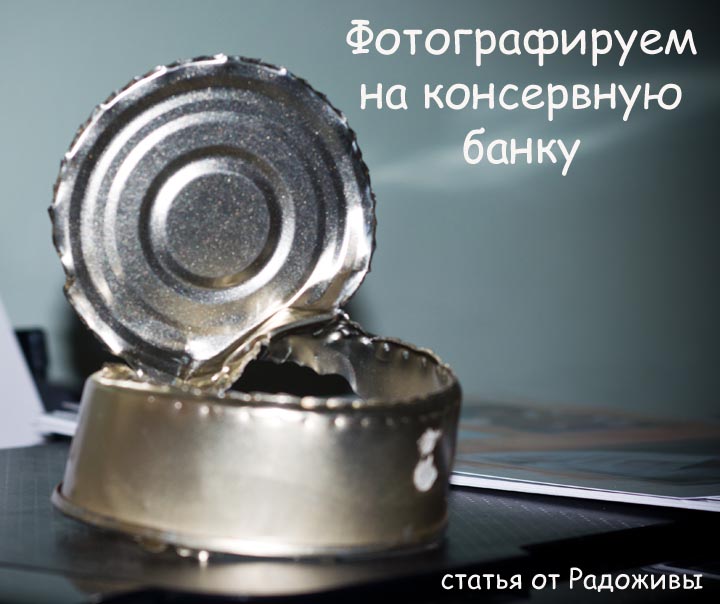
Creating a Lens from a Tin Can
So, let's begin. We will need, of course, a tin can, you can eat the contents yourself, or treat a cat, a dog and a few more simple things. What's the point? The bottom line is what you can try to do pinhole (pin - point, hole - hole).
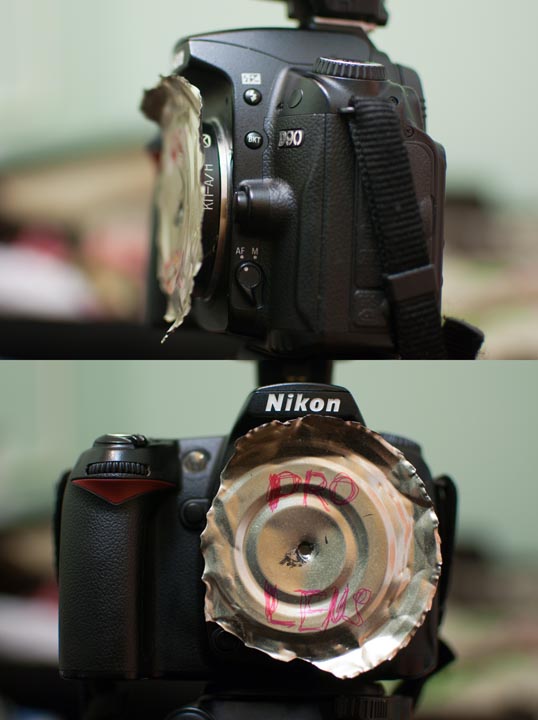
Pinhole view on camera. Tin can lens
How to do:
- You need to take solid material, preferably something iron and the thicker the metal, the better.
- Make a small hole there. Ideally, a hole should be made in a strong blackened material with a laser with a diameter less than 0,15mm. The smaller the hole diameter, the sharper the image will be in most cases.
- Attach the resulting piece of material with a hole instead of the lens to the camera.
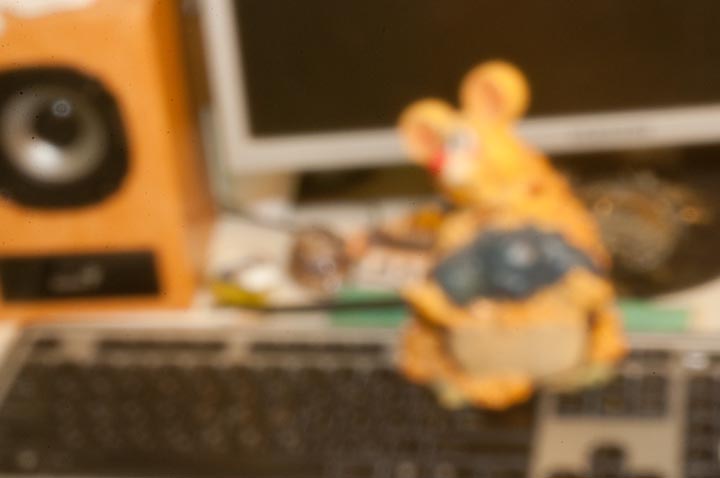
Pinhole photo. Photo on a tin can. toy mouse
How did i:
Cut the bottom of the can, drew two lines. The intersection of the lines gave an exact center. In the center with a small screw pierced a small hole. The needle aligned the edges of the hole. Blackened a hole with a marker. Put the cover on the shank KP-A \ N with glue to sit on the camera. Slightly curved the edges of the can. I hooked on the camera. During filming excerpt there were 30 seconds everywhere. The flash worked in a strobe mode of 30 pulses of 1 \ 16 power.
Installation disadvantages:
- Due to the small aperture value, almost all dust particles and any dirt will be visible on the matrix.
- Installation requires both physical and intellectual efforts to assemble it, and then use it.
- Low contrast and detail picture.
- Inability to focus. Moreover, this means that before the shutter is released, the frame layout is not visible in the viewfinder.
- The duration of the process. Without a flash, this setup takes several minutes. excerpts.
- For shooting, you need the camera itself (body). You can make a film version without a camera, but it's a little more complicated.
Here's what happened in thumbnails:
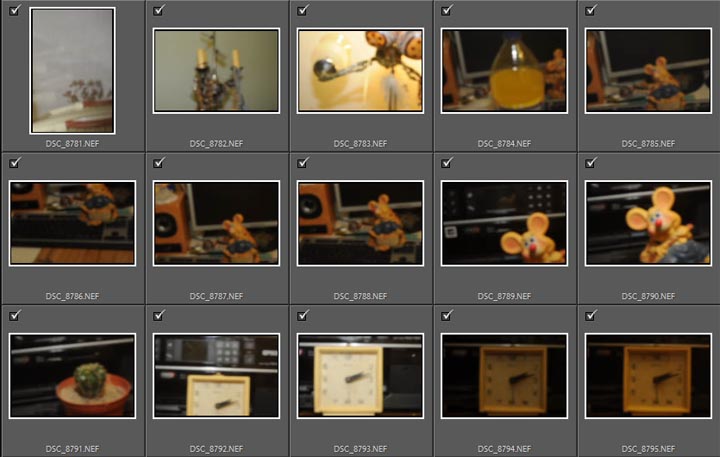
Thumbnail photo of can
Advantages of installation:
- Cheapness. Class lens Pinhole I made it cheaper than for 1.u.e., canned goods are now cheap.
- No perspective distortion. Since there are no lenses in the installation, there are no distortions.
- Huge DOF (depth of sharply depicted space). The larger the aperture value, the greater the depth of field. In this case, you can achieve a huge depth of field, as in terms of the values we get somewhere F40-F90.
- Patriots of any country can use the lens produced in their homeland. It is unlikely that one can now find lenses that are made in Ukraine, but tin cans are very popular. Therefore, you can proudly add Made in Ukraine or in any other country and have a unique lens. But, and if jokes set aside, then the availability of such an installation.
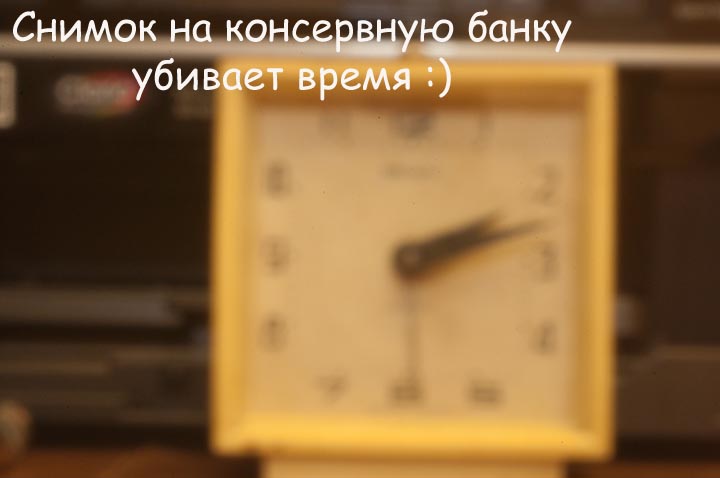
photo on a tin can
Features to watch out for:
Pinhole you can put it on the rings for macro photography, thereby making the angle of view narrower and achieve a longer focal length, or vice versa, drown into the bayonet closer to the mirror, making the angle wider. The easiest way to make a pinhole is to drill a camera mount cover. I put a piece of metal from a tin can on the KP-A \ N shank, which was lying around idle. The smaller the hole, the sharper the image will be, however, too, up to a certain limit. By eye, I got a hole with a diameter of 0.5 mm, but this is too much. At the end of the work, I slightly widened the hole and got generally blurry frames.
So after reading this article, you can be firmly convinced that you can even shoot on a tin can, although it will be difficult to achieve a good result.
Hack and predictor Aviator:
Pinhole (pinhole camera) - An interesting and very cheap version of the simplest lens with which you can conduct photo experiments. Him not necessarily made from a can... Experiments of this kind provide an insight into how the camera works in general and serve as a good lesson for the budding photographer. And to tell someone that can be removed on a tin can ... they won't believe it.
I would be grateful for +1, tweet or like. Thanks for attention. Arkady Shapoval.


Thank you :)
I never thought that such a thing could be done.
Brilliant, Holmes!
Thank you for the described experiment, maybe I'll someday use it and expand the possibilities)))
Great article and blog. Everything is explained clearly, especially for such a miracle of users like me, in particular. I will definitely use your recommendations. Like everything I can, this blog is worth noting.
Thank you)))
Arkady, I’ve been sitting on your site for a week, bookmarking it on all my computers .. I haven’t read more fascinating articles than your articles and reviews .. Huge respect and respect for your work .. Bravo!
Thanks. Don't forget to like the reviews.
the tin can is very thick for such tricks. it would be more correct to use foil. and certainly not with a screw to drill)
Well, the actual article is aimed at showing that this is possible)
wow !!! super fun !!
Or maybe make “+1, tweet or like” for “VKontakte” and “classmates”?
I want to talk about you, but on Twitter and Facebook is not registered
ok, I’ll make a button for contact
Hah, thank you, I earned $ 100 on a bet that I’ll take to a tin = D
not at all
original article! and don’t have to worry about buying a new lens :)
inspired by memories :) I remember, 40 years ago, I experimented with a matchbox and a piece of film ... it worked!
brilliant experiment, take off my hat))
I also took off my hat, then like nothing, it turned out)))
Thanks to your comment, the morning for my neighbors began at four o'clock and I'm afraid they will get up on the wrong foot ...
what is this ingenious? this is in the net all the time: foil, a plastic cover with a jar and a bunch of crap. here it is necessary to drill a hole in the piece of iron it is necessary. generally rare garbage turned out. IMHO
Once, several decades ago, I was familiar with the Photographer, a master from God .. It was he who carried me into photography .. One of his fascinating stories was the story of his first camera - a camera from a sintered box .. These are the basics, you need to know them to create ... And then you start to believe in miracles and any nonsense .. And miracles do not happen, there is the physics of the process
Why bullshit? This is just an experiment! It shows some of the physical properties of light passing through a kind of such a lens ... But the real bullshit is a demonstration of fashion (clothes) that no one will wear from famous fashion designers who are not known for what they are needed. It is not clear at all for what purpose this rag is sewn and why it is shown on TV…. This is real bullshit….
Hello. Arkady, a special hello to you. You taught a lot. But that's just not to my liking. And it seemed like a big stupidity. What is the relish? The photos are not beautiful, not clear and even very cloudy. They do not cause delight and joy. Maybe I don't understand something ... But ... alas.
The principle is shown here.
Vladimir, and you just smile more often))) Is it necessary to look in everything for some special, deeply buried meaning?
A friend made a pinhole from a matchbox and reels with a film)))) This is trash)))
the inscription on the "lens" smiled !!!)))
Thank you very much, Arkady! There are some things that would be interesting to do, but practical expediency stops, and there remains a mystery for life: “What would happen if ...” Thank you for expanding your horizons! I enjoyed reading about serious lenses. When I got to the filmoscope, I wanted to propose an obscura to complete the picture, looked at the comments - and it already exists! Thanks!
Regarding the description, I would suggest calling the impossibility of focusing the absence of the need for focus :)
For all its awkwardness, the camera obscura is the mother of the camera.
This experiment was done jokingly, and if you rummage through the old literature, you can find the calculations of holes and focal lengths. I once led a photo circle and showed the boys how to take a picture
matchbox, ballpoint pen cap, what started here ...
Each and every one (12 people) abandoned their
Shifts, FEDs, Seagulls and let's invent
espionage technique. As a result, we did
an entire exhibition of espionage technology and photographs.
If this experiment is done more accurately, punch a hole with a needle, remove burrs, put furs for macro photography,
black metal or replace with black plastic, fiber, then the picture will be very surprising
skeptics with its sharpness with its softness (almost a monocle) ...
google "pinhole" and see the pictures. everything will become clear! Great things can be done!
I remembered how I watched pictures taken with the help of the Holga Pinhole. Very atmospheric. True, in all cases, noticeable vignetting, however, is not perceived as a disadvantage, rather as an expressive device.
In fairness, I still want to note that lenses are still produced in Ukraine, in the same arsenal :)
Interested in this method of removal! : D
I sawed a hole about one and a half centimeters in diameter in the carcass hollow plug (oh and smelly plastic she had), pasted aluminum tape and pierced it with the tip of an acupuncture needle! I can say that the sharpness really depends on the diameter a lot! But the smaller the diameter, the longer the shutter speed ... In general, with a hole of about 0.1-0.2 mm, blackened with a candle, it's already not bad, you can shoot "bezishodnost" in b / w ...: D You can almost readable to remove text in A4 format ... But you want more! I will try again! It seems to me that aluminum tape is convenient in this regard ...
I also tried to sculpt the same adhesive tape on a 42mm adapter and on macro rings - indeed, the focal length changes! I tried to make a lot of holes - the effect of a kaleidoscope is obtained! :]
I also noticed such a feature - when you shoot with a pinhole, the dust particles (probably) on the matrix become very intrusive, they stand out very strongly in each picture! While when working with other lenses, they are not observed! I made an assumption that this is due to the size of the hole close to the size of the dust particles, and the smaller the hole, the harder the shadow from the dirt on the matrix will be, and the sharper this dirt will appear in the pictures ...
A great way to assess the purity of the matrix by the way! Judging by your review, your hole is very large, but the gras can already be seen!
I must also say that the composition of the frame with a smaller aperture becomes almost unrealistic, just take a picture and then move the camera "by eye" ... But nevertheless, it's interesting! As I drink a more or less viable pinhole, go out into the street with it, I can post something! :]
Arkady, as I understand it, you were not particularly keen on this technique of shooting outside this article?
And here's another interesting thing about the pinhole. He took care of the increase in sharpness (as you know, blur is a feature of pinhole and infuriates). I attached my pinhole with Velcro to the back of the transition ring on the M42 (so that it is closer to the matrix), and on the helios ring 44. In short, the pinhole between the lens and the matrix. The analogy with the diaphragm begs, only until such a hole does it close. I shot with a shutter speed of 8-20 seconds (the aperture itself is max open). Result: amazing depth of field (from 10 cm to 5 m), but the sharpness itself is not ringing only, that is, all objects in the foreground and background are equally slightly blurry. Here the reason is probably either the hole is not round, or not in the center, or the arms are crooked. For comparison, I took it without a pinhole; I could not get such a depth and close. Summary: if there is a plot where maximum depth of field is required, you can adjust the pinhole between the lens and the matrix. Only with straight arms.
Andrei read your research, only your descriptions do not correspond at all to the correct idea. The concept of depth of field in a pinhole is absent as such, in other words, it is not necessary to think about it since the maximum depth is from a hole to infinity and the diameter or design of a hole does not affect the depth in any way. All that really cares in the pinhole is to achieve sharpness. And it depends 1. on the thickness of the material, the thinner the sharper and the smallest hole should be made from the diameter of the hole. Sharpness does not depend on how you write that the hole is not centered. http://rasfokus.ru/blogs/vse-velikoe-rjadom/foto-bez-obektiva.html
Made of M-42 macro rings, holding a black film between the printer cartridge between them, it is not transparent. I sharpened the needle on the bar, carefully made a hole approx. 0,5mm. In principle, sharpness is acceptable.
I read and heard about the pinhole many times, but still I can’t understand why?!? It’s just unpleasant to look at such pictures.
In the picture, the answer is why the pinhole on digital cameras is bad.
Yes, the point is micro lenses on the matrix.